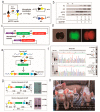ФC31 Integrase-Mediated Isolation and Characterization of Novel Safe Harbors for Transgene Expression in the Pig Genome
- PMID: 29300364
- PMCID: PMC5796098
- DOI: 10.3390/ijms19010149
ФC31 Integrase-Mediated Isolation and Characterization of Novel Safe Harbors for Transgene Expression in the Pig Genome
Abstract
Programmable nucleases have allowed the rapid development of gene editing and transgenics, but the technology still suffers from the lack of predefined genetic loci for reliable transgene expression and maintenance. To address this issue, we used ФC31 integrase to navigate the porcine genome and identify the pseudo attP sites suitable as safe harbors for sustained transgene expression. The combined ФC31 integrase mRNA and an enhanced green fluorescence protein (EGFP) reporter donor were microinjected into one-cell zygotes for transgene integration. Among the resulting seven EGFP-positive piglets, two had transgene integrations at pseudo attP sites, located in an intergenic region of chromosome 1 (chr1-attP) and the 6th intron of the TRABD2A gene on chromosome 3 (chr3-attP), respectively. The integration structure was determined by TAIL-PCR and Southern blotting. Primary fibroblast cells were isolated from the two piglets and examined using fluorescence-activated cell sorting (FACS) and enzyme-linked immunosorbent assay (ELISA), which demonstrated that the chr1-attP site was more potent than chr3-attP site in supporting the EGFP expression. Both piglets had green feet under the emission of UV light, and pelleted primary fibroblast cells were green-colored under natural light, corroborating that the two pseudo attP sites are beneficial to transgene expression. The discovery of these two novel safe harbors for robust and durable transgene expression will greatly facilitate the use of transgenic pigs for basic, biomedical and agricultural studies and applications.
Keywords: pig; pseudo attP site; safe harbor; transgene; ФC31 integrase.
Conflict of interest statement
The authors declare no conflict of interest. The founding sponsors had no role in the design of the study; in the collection, analyses, or interpretation of data; in the writing of the manuscript, and in the decision to publish the results.
Figures


Similar articles
-
Pseudo attP sites in favor of transgene integration and expression in cultured porcine cells identified by Streptomyces phage phiC31 integrase.BMC Mol Biol. 2013 Sep 8;14:20. doi: 10.1186/1471-2199-14-20. BMC Mol Biol. 2013. PMID: 24010979 Free PMC article.
-
A phiC31 integrase-mediated integration hotspot in favor of transgene expression exists in the bovine genome.FEBS J. 2009 Jan;276(1):155-63. doi: 10.1111/j.1742-4658.2008.06762.x. FEBS J. 2009. PMID: 19019083
-
Site-specific transgene integration in the human genome catalyzed by phiBT1 phage integrase.Hum Gene Ther. 2008 Feb;19(2):143-51. doi: 10.1089/hum.2007.110. Hum Gene Ther. 2008. Retraction in: Hum Gene Ther. 2010 Aug;21(8):1036. doi: 10.1089/hum.2010.1513. PMID: 18067406 Retracted.
-
ΦC31 integrase mediates efficient site-specific integration in sheep fibroblasts.Biosci Biotechnol Biochem. 2012;76(11):2093-5. doi: 10.1271/bbb.120439. Epub 2012 Nov 7. Biosci Biotechnol Biochem. 2012. PMID: 23132571
-
PITT: pronuclear injection-based targeted transgenesis, a reliable transgene expression method in mice.Exp Anim. 2012;61(5):489-502. doi: 10.1538/expanim.61.489. Exp Anim. 2012. PMID: 23095812 Review.
References
MeSH terms
Substances
Supplementary concepts
LinkOut - more resources
Full Text Sources
Other Literature Sources

